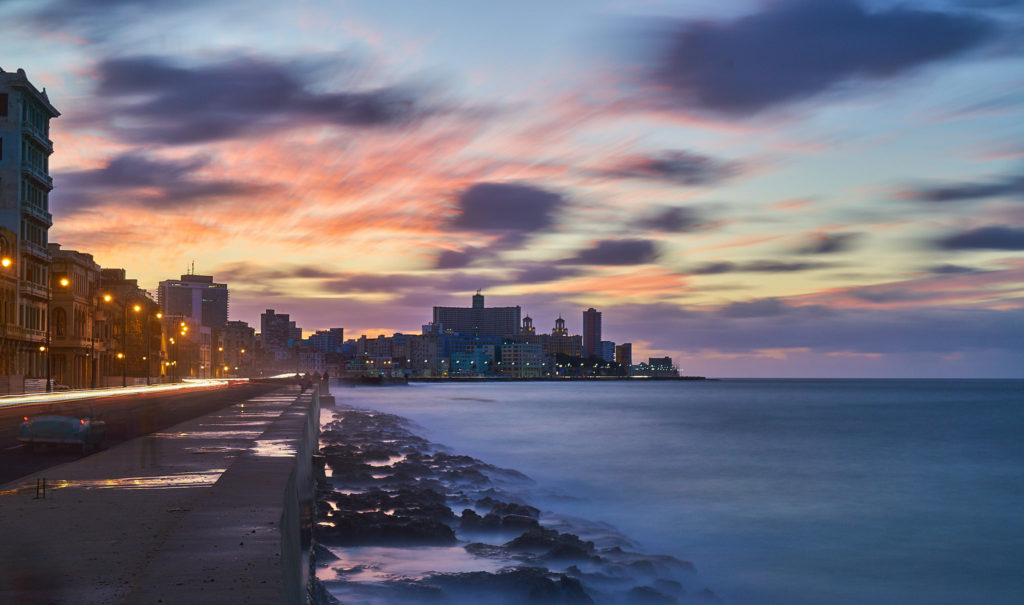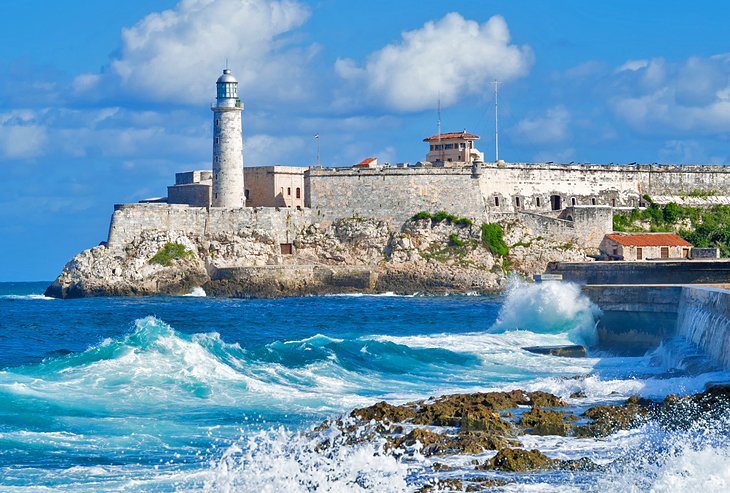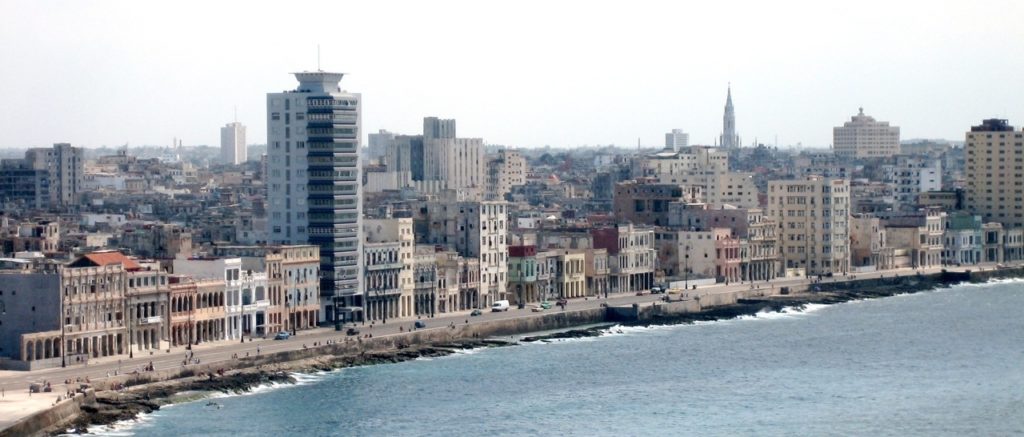LA HABANA Y SU FAMOSO “MALECÓN”, EL SOFÁ MAS LARGO DEL MUNDO COMO LE LLAMAN. FOTOS.
Este paseo peatonal junto al mar de la bella y parcialmente destruida ciudad por el actual abandono se extiende desde el Castillo de San Salvador de la Punta en La Habana Vieja hasta el río Almendares que separa Vedado de Miramar (alrededor de 7 km / 4 1/4 millas en total). Ningún viaje a La Habana está completo sin pasar al menos un rato paseando y holgazaneando por el Malecón, que es el centro social de una amplia gama de cubanos. A lo largo del día, verá niños nadando y hombres pescando en los afloramientos de coral que bordean el paseo marítimo, y por la noche, seguramente verá amantes entrelazados en cómodas perchas y grupos de juerguistas a lo largo del malecón.
De punta a punta, el Malecón comienza en la Bahía de La Habana en La Habana Vieja, y bordea el lado norte del barrio de Centro Habana antes de terminar en el Vedado. Como la mayor parte del malecón también funciona como un lugar para sentarse o acostarse, es posible que escuche a los lugareños comentar que el Malecón es “el sofá más largo del Mundo”, ¡el sofá más largo del mundo!
LA HISTORIA DE “EL MALECON” HABANERO…
Los planes se elaboraron por primera vez en el siglo XIX para crear un malecón para proteger la ciudad. Al igual que con otras ciudades del mundo, era evidente que los diques resistentes podían servir de protección contra los mares tormentosos y las mareas anormalmente altas. La primera construcción tuvo lugar a principios del siglo XX y el muro se amplió aún más en las décadas de 1920, 1930 y 1950. Con el aumento del nivel del mar, recientemente se han llevado a cabo conversaciones para aumentar la altura del muro y ayudar a proteger la ciudad para el futuro.
Cuando se llevó a cabo la primera etapa de construcción a principios del siglo XX, su nombre oficial era “Avenida de Golfo”, que significa “Avenida del Golfo”, el Golfo se refiere al Golfo de México al que se enfrentaba esa primera sección del muro. Sin embargo, los lugareños rápidamente comenzaron a llamarlo “El Malecón” y desde entonces el nombre se ha mantenido. “Malecón” en inglés se puede traducir aproximadamente como “esplanade” o “seawall”. Técnicamente, hoy en día, el tramo de carretera y pavimento que se conoce como Malecón consta de varias “Avenidas” con nombres diferentes, pero en la conversación cotidiana e incluso en las publicaciones y cartografía oficiales (incluido Google Maps), el nombre “Malecón” es comúnmente utilizado.
Algunos de los datos curiosos sobre el famoso “Malecón” de La Habana son:
– Es considerado Monumento Nacional. En 1991, el Consejo Nacional de Patrimonio Cultural de Cuba (“Consejo Nacional de Patrimonio Cultural”) declaró oficialmente el Malecón como “Monumento Nacional” y, en consecuencia, ahora es un “Área Protegida” (“Zona de Protección”).
– Tiene un papel para los seguidores de la Santería. Para los lugareños que practican la santería, el Malecón es un lugar desde donde se pueden lanzar ofrendas a la diosa Yemayá-Asesú, de quien se dice que habita a la orilla del mar. Las ofrendas suelen adoptar la forma de varias (idealmente siete) monedas de bajo valor. Si el mar está particularmente tormentoso, se cree que esto significa que la diosa Yemayá-Olokun, de quien se dice que vive en lo más profundo del mar, está enfadada.
– Es un lugar popular para la pesca. Al estar junto al mar, el Malecón es un lugar popular para pescar, especialmente en ciertos lugares a lo largo del malecón. A veces se puede ver a los pescadores usando condones de látex inflados como flotadores, ya que son mucho más baratos que los equipos más especializados. Si bien algunas especies de peces se pueden capturar cerca de la costa, estos condones flotantes se desplazan hacia el mar con el sedal, lo que permite a los pescadores capturar peces más grandes en aguas más profundas sin necesidad de salir del malecón.
– El amor está en el aire. El Malecón siempre ha sido popular entre las parejas, ya sea que hayan estado juntos durante muchos años o que tengan una primera cita. A algunos se les puede ver paseando tranquilamente por el paseo marítimo, mientras que otros optan por sentarse en el malecón. También es un lugar popular entre familias y amigos, que a veces traen comida, bebida y entretenimiento para animar la noche. De hecho, casi todos los que visitan o viven en la ciudad vendrán aquí en algún momento, para relajarse, reflexionar o divertirse, según la ocasión.
– A las 9 de la noche todas las noches se puede escuchar un fuerte estruendo. Cada noche se lleva a cabo una ceremonia centenaria en la fortaleza de Cabaña, que culmina con un cañonazo a las 9 pm en punto. En siglos pasados esto marcaba el cierre de las puertas de la ciudad, aunque ahora se hace por tradición. La fortaleza de Cabaña está ubicada al otro lado de la Bahía de La Habana hacia el Malecón, pero el sonido del cañón es tan fuerte que se puede escuchar desde casi todos los puntos del Malecón.
– De vez en cuando se puede caminar en medio de la carretera. Si bien la vista de autos antiguos circulando por la vía principal del Malecón es una imagen clásica de La Habana, la vía principal del Malecón es igualmente especial cuando está cerrada, con menos ruido de los automóviles y un ambiente diferente. A veces cierra por festivales especiales, desfiles y celebraciones. Otras veces se cierra si hay mares particularmente agitados, lo que hace que las olas rocíen agua de mar sobre el malecón. Es la naturaleza contraatacando, y ciertamente un espectáculo que vale la pena ver de cerca, ¡pero ten cuidado porque te puedes mojar!
– Ha habido tres cócteles principales que llevan el nombre del Malecón. Como ocurre con muchos cócteles que datan de muchos años, los orígenes de la primera versión del cóctel Malecón son confusos. Dicho esto, uno de los primeros documentos impresos que contiene el cóctel del Malecón data de 1915, cuando apareció en la guía de cócteles cubanos de John Escalante, conocida como el “Manual del Cantinero”. Los ingredientes incluían coñac, vermú, amargo de angostura, jarabe de azúcar y una guarnición de fresa.
En 1941, se inventó un cóctel estadounidense llamado Malecón que, según se decía, estaba inspirado en La Habana y figuraba en “Cocktail Guide and Ladies’ Companion” de Crosby Gaige. Los ingredientes enumerados son ginebra seca, ron blanco, “punch” sueco y brandy de albaricoque.
El tercer cóctel exitoso del Malecón fue creado en 2007 en Londres por Eric Lorincz cuando era cantinero en el Connaught Bar. La idea se le ocurrió después de un viaje a La Habana y rápidamente se convirtió en un éxito de ventas. Los ingredientes incluyen ron, oporto, jerez, amargo de Peychaud, azúcar extrafino y jugo de lima. Al pensar en la idea, comentó:
“He leído que la esencia de lo que significa ser cubano es aceptar lo inevitable de la existencia humana, que nacemos y debemos morir, y sacar lo mejor de la vida intermedia y pasarla lo mejor posible. Con esta actitud admirable en mente, quise crear una bebida que pudiera ser disfrutada a cualquier hora del día o de la noche, y que fuera en casa en la coctelería más elegante de Londres e igualmente en el Malecón de La Habana con música, risas. y humo de tabaco en el aire”.
La sección frente a Centro Habana es quizás la más pintoresca, con las fachadas desmoronadas y la pintura descolorida de los edificios y apartamentos neoclásicos y neomoriscos que bordean la avenida que separa el Malecón de la ciudad.
Si tiene piernas y tiempo, una caminata desde el Hotel Nacional hasta La Habana Vieja (o viceversa) solo le llevará unos 25 minutos. En los días difíciles, es posible que tengas que cronometrar tus pasos, o cruzar la calle, mientras las olas rompen con furia sobre el malecón.
HAVANA AND ITS FAMOUS “MALECÓN”, THE WORLD’S LONGEST SOFA AS IT IS CALLED. PHOTOS
This oceanside pedestrian walkway stretches all the way from the Castillo de San Salvador de la Punta in La Habana Vieja to the Almendares River that separates Vedado from Miramar (about 7km/4 1/4 miles in total). No trip to Havana is complete without at least some time spent strolling and lingering along the Malecón, which is the social center for a wide range of Cubans. Throughout the day, you’ll see children swimming and men fishing off the coral outcroppings that border the walkway, and at night, you’re sure to see lovers entwined on cozy perches and groups of revelers all along the seawall.
From end to end, the Malecon starts at Havana Bay in Old Havana, and skirts along the north side of the neighborhood of Havana Centro before ending in Vedado. As most of the seawall also functions as a place to sit or lay down, you might hear locals remark that the Malecon is “el sofá más largo del Mundo” – the world’s longest sofa!
“EL MALECON” HABANERO” STORY…
Plans were first drawn up in the 1800s to create a seawall to protect the city. As with other cities around the world, it was evident that sturdy seawalls could provide a buffer against stormy seas and abnormally high tides. The first construction took place in the early 1900s, and the wall was further extended in the 1920s, 1930s, and 1950s. With rising sea levels, talks have recently been taking place to enlarge the height of the wall to help protect the city for the future.
When the first stage of construction took place in the early 1900s its official name was “Avenida de Golfo”, meaning “Gulf Avenue” – the Gulf referring to the Gulf of Mexico which that first section of the wall was facing. However, locals quickly started calling it “El Malecón” and since then the name has stuck. “Malecon” in English can roughly be translated into “esplanade” or “seawall”. Technically today the stretch of road and pavement that is referred to as the Malecon consists of several differently named “Avenida” (avenues), but in everyday conversation and even in official publications and cartography (including Google Maps), the name “Malecon” is commonly used.
Some of the fun facts about Havana’s famous “Malecon” are:
– It is considered a National Monument. In 1991 the Cuban National Council of Cultural Heritage (“Consejo Nacional de Patrimonio Cultural”) officially declared the Malecon to be a “National Monument”, and consequently it is now a “Protected Area” (“Zona de Protección”).
– It plays a role for followers of Santería. For locals that practice Santería, the Malecon is a spot from which offerings can be thrown to the goddess Yemayá-Asesú, who is said to inhabit the seashore. Offerings usually take the form of several (ideally seven) low-value coins. If the sea is particularly stormy, it is believed that this means that the goddess Yemayá-Olokun, who is said to live in the deepest depths of the sea, is angry.
– It is a popular spot for fishing. Being next to the sea makes the Malecon a popular spot from which to catch fish, especially in certain locations along the seawall. Anglers can sometimes be seen using inflated latex condoms as floats, as they are much cheaper than more specialized gear. Whilst some species of fish can be caught close to the shore, these floating condoms drift out to sea with the fishing line, allowing the anglers to catch bigger fish in deeper waters without needing to leave the seawall.
– Love is in the air. The Malecon has always been popular with couples, whether they have been together for many years or are going on a first date. Some can be seen gently strolling along the promenade, whilst others choose to sit on the seawall. It is also a popular spot with families and friends, who sometimes bring food, drink, and entertainment to liven up the evening. In fact, just about everyone visiting or living in the city will come here at some point, to relax, reflect, or party, depending on the occasion.
– At 9 pm every night you can hear a loud bang. A centuries-old ceremony takes place every evening at the Cabaña fortress, which culminates in a cannon blast at 9 pm on the dot. In centuries gone by this was to mark the closure of the city gates, though now it is done out of tradition. The Cabaña fortress is located on the other side of Havana Bay to the Malecon, but the sound of the canon is so loud that it can be heard from almost every spot along the Malecon.
– Occasionally you can walk in the middle of the road. Whilst the sight of old cars cruising along Malecon’s main road is a classic image of Havana, Malecon’s main road is equally special when it is closed, with less noise from cars and a different ambiance. Sometimes it closes for special festivals, parades, and celebrations. Other times it closes if there are particularly rough seas, causing waves to spray seawater over the seawall. It is nature fighting back, and certainly a spectacle worth watching up close, but be careful as you might get wet!
– There have been three major cocktails named after the Malecón. As with many cocktails that date back many years, the origins of the first version of the Malecon cocktail are cloudy. That said, one of the first printed documents to contain the Malecon cocktail is in 1915 when it was featured in John Escalante’s guide to Cuban cocktails, known as the “Manual del Cantinero” (‘Bartender’s Manual’). The ingredients included cognac, vermouth, Angostura bitters, sugar syrup, and a strawberry garnish.
In 1941, an American cocktail was invented called Malecon that was said to be inspired by Havana and featured in Crosby Gaige’s “Cocktail Guide and Ladies’ Companion”. Ingredients listed are dry gin, white rum, Swedish “punch” and apricot brandy.
The third successful Malecon cocktail was created in 2007 in London by Eric Lorincz when he was a bartender at the Connaught Bar. He came up with the idea after a trip to Havana, and it quickly became a bestseller. Ingredients include rum, port, sherry, Peychaud Bitters, caster sugar, and lime juice. On coming up with the idea, he remarked:
“I have read that the essence of what it means to be Cuban is to accept the inevitabilities of human existence, that we are born and must die, and to make the very best of the life in between and have as good a time as possible. With this admirable attitude in mind, I wanted to create a drink that could be enjoyed at any time of day or night, and that would be at home in the most elegant London cocktail bar and equally at the Malecón in Havana with music, laughter, and tobacco smoke in the air.”
The section fronting Centro Habana is perhaps the most picturesque, with the crumbling facades and faded paint of neoclassical and neo-Moorish buildings and apartments lining the avenue that separates the Malecón from the city.
If you’ve got the legs and time, a walk from the Hotel Nacional to La Habana Vieja (or vice versa) should only take you about 25 minutes. On rough days, you may have to time your steps — or cross the street — as waves break furiously over the seawall.
Agencies/ Wiki/ CubaDirect/ ElMaleconHist./ Extractos/ Excerpts/ Internet Photos/ Arnoldo Varona/ www.TheCubanHistory.com
THE CUBAN HISTORY, HOLLYWOOD.









